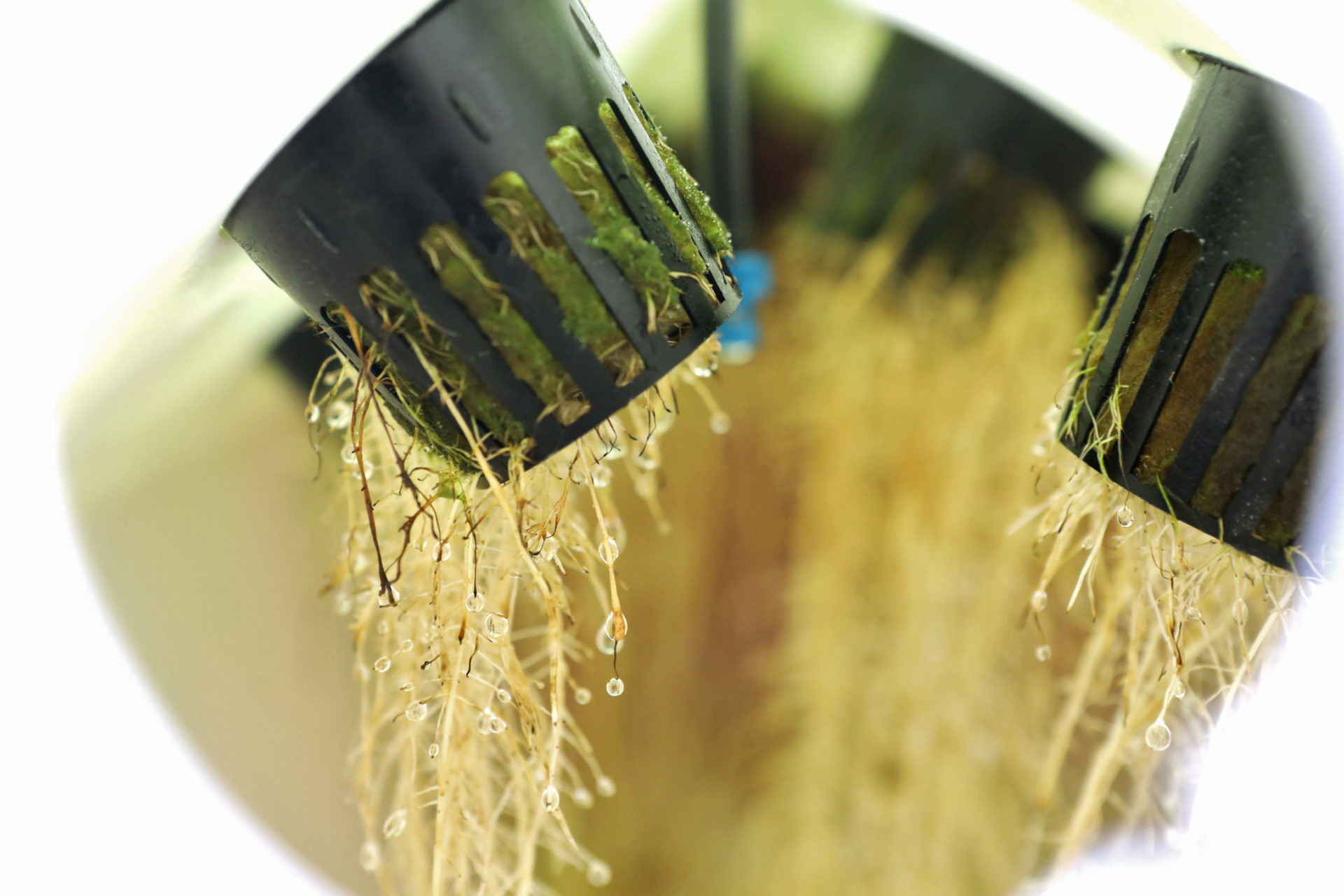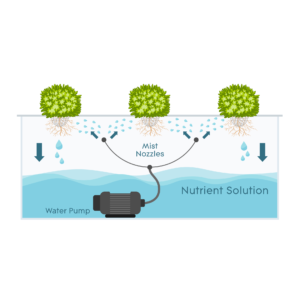Aeroponics is a subset of water culture, and while it is considered a type of hydroponics, it’s also quite different. In an aeroponic system, plants sit above the mist chamber with roots suspended beneath. A fine mist of nutrient enriched water sprays on the roots, providing an optimal balance of moisture, nutrients, and aeration.
Because of this highly efficient schematic, it’s one of the most effective hydroponic systems. Growers conserve more resources, like water, while also gaining higher yields with faster growing crops.

Check out this video of astronauts growing with aeroponics!
Different Types of Aeroponic Systems
Within aeroponics, there are two main divisions: LPA (Low Pressure Aeroponics) and HPA (High Pressure Aeroponics).
Low Pressure Aeroponics
LPA systems are more akin to regular sprinklers. The mist they produce forms larger droplets, and so a lot of people refer to low pressure aeroponics as Soakponics. Many hobbyists use these systems simply because they’re easier to set up. Not only that, it’s a lot easier to obtain the equipment you need from your local gardening store.
Pond and fountain pumps are the top choice for LPA systems. However, these pumps are only rated in GPH (Gallons Per Hour) and not PSI (Pounds per Square Inch). Because of that, the droplet size isn’t specific. The pump connects to a nutrient reservoir and tubing, through which it delivers nutrient enriched water to sprinkler heads or nozzles.
High Pressure Aeroponics
HPA systems are much more specific in setup and droplet size than LPA systems. They’re sometimes called true aeroponics, since the mist they deliver is very fine. The pumps for high pressure aeroponic systems should be rated at least 60-90 PSI to produce the correct size of droplets. While the equipment is somewhat more complicated, there are several advantages to HPA systems. Roots take in more oxygen due to the smaller droplet size. They also absorb more nutrients, and at a faster rate. As a result, plants in high pressure systems grow larger root systems.
Plants do best when droplets are between 20 to 50 microns in size. Because they absorb the mist more efficiently, there’s little need to have a constant spray on the roots. Misting intervals are typically under 5 seconds in length. The cycles are frequent, so roots don’t dry out. A timer sets off the misting cycle, usually every 5 minutes or so. Naturally, this means the plants can be fed up to hundreds of times a day.
High pressure aeroponics also shortens the time it takes plants to grow to harvest. In most cases, plants have a 25% shorter grow cycle.
Yield Differences
While there are differences in overall yields between high pressure and low pressure aeroponic systems, the real difference shows when compared to other types of hydroponic systems.
In this guide, we’ll be paying special attention to the yields of leafy greens such as basil or lettuce.
Because leafy greens grow faster, and show more obvious growth compared to other crops, they make for an ideal study subject. Not only that, leafy greens are crops easily grown with fluorescent grow lights, such as T5 or CFL bulbs with sufficient wattage.
A study by Suman Chandra et. al 2014, shows the difference between field grown and aeroponically grown leafy greens.
Each species of leafy green vegetable was studied with 72 plants in both field and aeroponic systems. While Red Kale (Brassica oleracea) shows the most impressive difference, the results are undeniable. Leafy greens show markedly higher growth, and yields, in aeroponic systems.
The results, briefly, are as follows:
- Field grown Red Kale yields only 272.56 grams, while aeroponic Red Kale yields 450.24 grams. That’s an impressive 177.68 gram difference.
- Parsley has the next largest growth difference, with field crops yielding 342.04 grams, and aeroponic crops yielding 414.64 grams. In total, a 72.6 gram difference.
- Field grown Chard produces a yield of 228.22 grams, with aeroponic Chard yielding 246.78 grams. Again, aeroponics produces the larger yield, with 18.56 grams more.
- Basil also shows obvious improvements in an aeroponic system at 388.14 grams, with field plants yielding only 326.64 grams. Aeroponic basil leads with a 61.5 gram higher yield.
Considerations in Aeroponic Growing
While the study results speak for themselves, NASA has long touted the advantages of aeroponic cultivation over traditional agriculture. According to NASA study figures, crops average 45% to 75% more production (yields) overall.
Specific schematics of these systems still determine the maximum growth capabilities, however. One particular measurement weighs heavily on overall production. The distance between root zones and nutrients.
The greater the root system, the more nutrients plants absorb. However, if plants aren’t close enough to the misting nozzles, more energy goes to growing longer roots than foliage. In a study by Georgios Salachas et. al, 2015, basil plants show greater stem and leaf growth in more shallow channels.
Plants in 15 and 30 cm channels had more access to nutrients, because of their proximity to the misting nozzles. Other basil plants, growing in channels 70 cm deep, produced less stem and leaf weight throughout the duration of the study. By the end of the study, plants within the 15 and 30 cm channels measured approximately 60 cm in height. In contrast, plants from the 70 cm channels show around 40 cm of height.
The study ultimately shows plants with deeper channels at around ⅔ the size of those with more shallow channels.
When weighing dry root mass however, plants in the 70 cm channels far outweigh the others, at close to 9 grams. The deeper the channel, the heavier the dry root weight. However, little difference is seen between the plants in 15 and 30 cm channels, with both at around 7 grams of root weight.
Proximity Determines Nutrient Availability
What we can take from this is a lesson in root systems and nutrient absorption. It’s clear that plants with roots farther away from nutrient sources divert energy to growing more roots than foliage. This is in attempts to reach the nutrient source, although it lessens the resources plants put to growing foliage.
Strong, expanding root systems are important in allowing plants to continue taking in more nutrients. However, aeroponic plants benefit from closer misting. Plants that don’t need to ‘stretch’ roots to gain nutrients produce higher yields.
It’s a safe assumption that more shallow channels, and closer misters result in greater crop production. This is due to an increase in nutrient availability.
Want to learn more about hydroponic nutrients? Look here for info about nutrient solution, or check out a more detailed guide about nutrients here.
Yield Comparisons
For the full appreciation of aeroponic yields, it’s a good idea to compare it with other methods of cultivation.
Take tomatoes, for instance. Even a typical hydroponic system grows crops faster than in soil. With aeroponics, there’s even faster growth with higher yields.
In hydroponics:
- About 3 ½ harvests yearly
- Can take up to 4 months for a full harvest
- Fruit shows in just under 2 months (from cuttings)
- Up to 3 months for first fruit from seed
In aeroponics:
- Just under 8 harvests yearly (7.7)
- Plants produce full harvest in around 1 ½ months
- Fruits show within 10 to 30 days (starting from cuttings)
- Flowering may start almost immediately
In soil:
- Typically produce only 1 harvest yearly
- Total time from harvest to seed is up to 180 days
- Require 6 to 8 weeks before planting in soil
- Yields greatly depend on soil conditions and climate
- Susceptible to pests and disease (crops may be ruined)
Recommended aeroponic nozzles and spray heads:
20 Pack Brass Misting Nozzles Tees
90Pcs Atomizing Garden Sprinkler
MIXC 1/4-inch Mist Irrigation Kits




